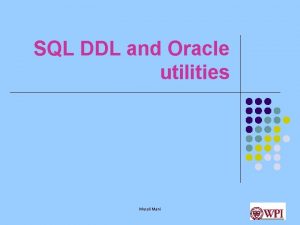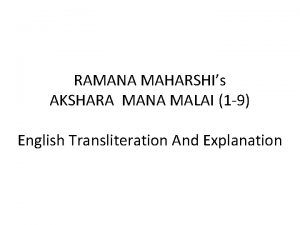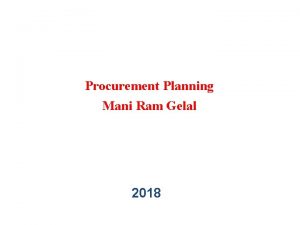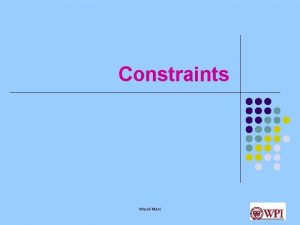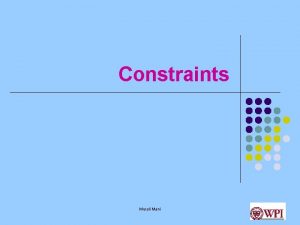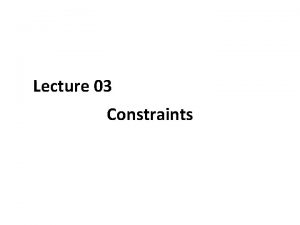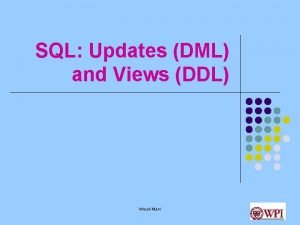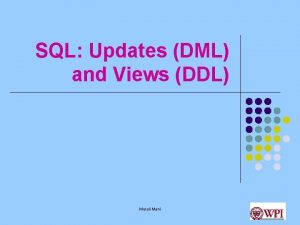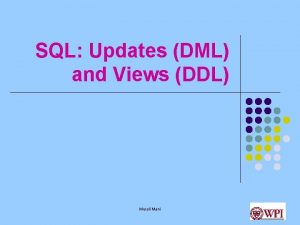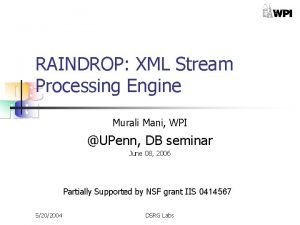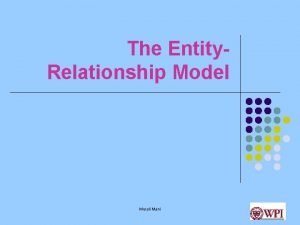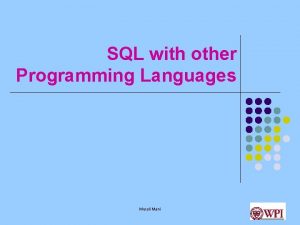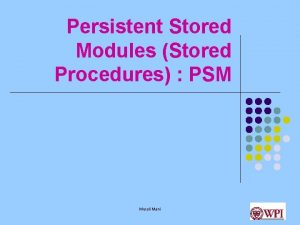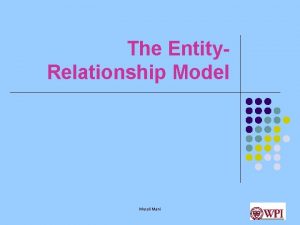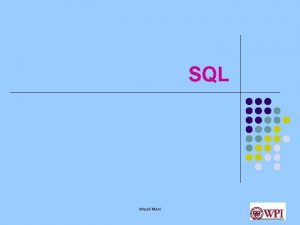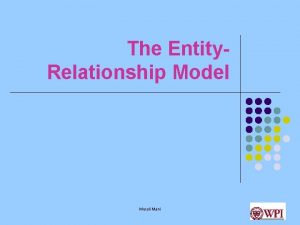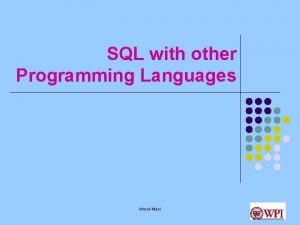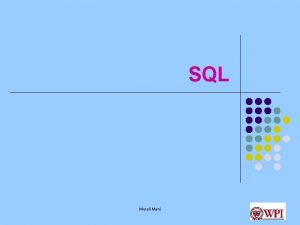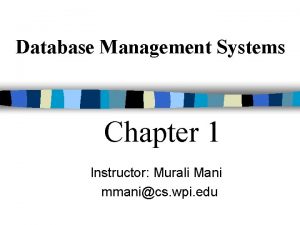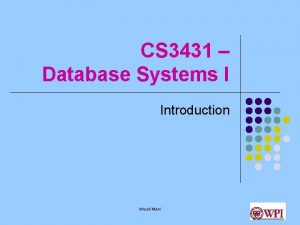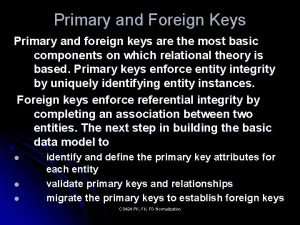Constraints Murali Mani Keys Primary keys and unique



![Foreign Keys: Referential Integrity Constraints l Specified for a table as [CONSTRAINT <fk. Name>] Foreign Keys: Referential Integrity Constraints l Specified for a table as [CONSTRAINT <fk. Name>]](https://slidetodoc.com/presentation_image_h2/bcddfbcc8ee140c14a1a329361842a26/image-4.jpg)




















![Triggers CREATE [OR REPLACE] TRIGGER <trigger. Name> BEFORE | AFTER INSERT|DELETE|UPDATE [OF <column. List>] Triggers CREATE [OR REPLACE] TRIGGER <trigger. Name> BEFORE | AFTER INSERT|DELETE|UPDATE [OF <column. List>]](https://slidetodoc.com/presentation_image_h2/bcddfbcc8ee140c14a1a329361842a26/image-25.jpg)

- Slides: 26

Constraints Murali Mani

Keys: Primary keys and unique CREATE TABLE Student ( s. Num int, s. Name varchar (20), dept char (2), CONSTRAINT key PRIMARY KEY (s. Num), CONSTRAINT unique. Name UNIQUE (s. Name)); Murali Mani

Unique vs. primary keys l l Attribute values may be null even if they are declared unique (primary key attributes should not be null). We can have any number of unique constraints for a table (only one primary key constraint can be defined for a table). Murali Mani
![Foreign Keys Referential Integrity Constraints l Specified for a table as CONSTRAINT fk Name Foreign Keys: Referential Integrity Constraints l Specified for a table as [CONSTRAINT <fk. Name>]](https://slidetodoc.com/presentation_image_h2/bcddfbcc8ee140c14a1a329361842a26/image-4.jpg)
Foreign Keys: Referential Integrity Constraints l Specified for a table as [CONSTRAINT <fk. Name>] FOREIGN KEY (<a 1 List>) REFERENCES <table. Name> (<a 2 List>) l eg: for example, for table R, we can specify FOREIGN KEY (x, y) REFERENCES S (a, b) l Requires (a, b) be unique or primary key of S. Consider a row in R with values of x as a 1, and y as b 1 where a 1, b 1 are both non-null. There must be a row in S with values for (a, b) as (a 1, b 1). l Murali Mani

Maintaining referential integrity: Inserts/Deletes/Updates l l l Default: reject any modification that violates the constraints. We can specify other policies for delete/update as set null/cascade. Eg: for Student relation FOREIGN KEY (prof) references Professor (p. Num) ON DELETE SET NULL ON UPDATE CASCADE Murali Mani

ON DELETE l Let us consider the foreign key on table R referencing table S such as FOREIGN KEY (x, y) REFERENCES S (a, b) l SET NULL l l If a delete is performed on S, any rows in R that reference that row in S have their (x, y) attributes set to null CASCADE l If a delete is performed on S, any rows in R that reference that row in S are also deleted. Murali Mani

ON UPDATE l SET NULL l l CASCADE l l If an update is performed on S, any rows in R that reference that row in S have their (x, y) attributes set to null If a delete is performed on S, any rows in R that reference that row in S are also updated. ON UPDATE constraints are not supported by Oracle Murali Mani

Example CREATE TABLE Student ( s. Num int, s. Name varchar (20), prof int, CONSTRAINT pk PRIMARY KEY (snum), CONSTRAINT uk 1 UNIQUE (sname), CONSTRAINT FOREIGN KEY (prof) REFERENCES Professor (p. Num) ON DELETE SET NULL); Murali Mani

Column Check constraints Constraints specified on a column l We can specify attributes as NULL or NOT NULL. l eg: s. Name varchar (20) NOT NULL l We can specify CHECK constraints. eg: gender char (1) CHECK (gender IN (‘F’, ‘M’)) salary int CONSTRAINT min. Salary CHECK (salary >= 60000) CONSTRAINT min. Salary check (salary >= 60000) Murali Mani

Other tips l While dropping a table such as S, where S is referenced by a FK from R, we can specify as ALTER TABLE S DROP COLUMN a CASCADE CONSTRAINTS; DROP TABLE S CASCADE CONSTRAINTS; Murali Mani

Altering Constraints l Constraints can be added to an existing table. ALTER TABLE ADD CONSTRAINT [<c. Name>] <c. Body> l Any constraint that has a name can be dropped ALTER TABLE DROP CONSTRAINT <c. Name> Murali Mani

Constraints on the entire relational schema Assertions: CREATE ASSERTION <assertion. Name> CHECK (<condition>) eg: CREATE ASSERTION CHECK ( NOT EXISTS (SELECT * FROM PROFESSOR WHERE salary < 60000)); Condition is any condition that can appear in WHERE clause. For any database modification, the assertion must be true. Assertions not supported by Oracle – could be very inefficient. Murali Mani

Triggers (Event, Condition, Action rules) l l We specify triggers as Event, Condition, Action rules; condition is optional. When event occurs, and condition is satisfied, the action is performed. Murali Mani

Triggers – Events, Action l Events could be BEFORE | AFTER INSERT ON <table. Name> | UPDATE | DELETE eg: BEFORE INSERT ON Professor l Action is specified as a body of PSM Murali Mani

Example Trigger Assume our DB has a relation schema Professor (p. Num, p. Name, salary) We want to write a trigger that ensures that any new professor inserted has salary >= 60000 Murali Mani

Example trigger CREATE OR REPLACE TRIGGER min. Salary BEFORE INSERT ON Professor FOR EACH ROW DECLARE temp int; -- dummy variable not needed BEGIN IF (: new. salary < 60000) THEN RAISE_APPLICATION_ERROR (-20004, ‘Violation of Minimum Professor Salary’); END IF; temp : = 10; -- to illustrate declared variables END; . run; Murali Mani

Things to note l l l FOR EACH ROW – specifies that for the trigger is performed for each row inserted : new refers to the new tuple inserted This trigger is checked before the tuple is inserted; if (: new. salary < 60000) then an application error is raised and hence the row is not inserted; otherwise the row is inserted. RAISE_APPLICATION_ERROR is built-in Oracle function. Use error code: -20004; this is in valid range Your trigger ends with a “. ” and a “run; ” Murali Mani

Displaying Trigger Definition Errors l When you define the trigger, you might get Warning: Trigger created with compilation errors. l l This means that there is/are errors in your trigger. To view the errors, show errors trigger <trigger_name>; l To drop a trigger drop trigger <trigger_name>; Murali Mani

Example trigger using Condition CREATE OR REPLACE TRIGGER min. Salary BEFORE INSERT ON Professor FOR EACH ROW WHEN (new. salary < 60000) BEGIN RAISE_APPLICATION_ERROR (-20004, ‘Violation of Minimum Professor Salary’); END; . run; l Conditions cannot be arbitrary conditions; they can use new rows etc. Murali Mani

Triggers: REFERENCING CREATE OR REPLACE TRIGGER min. Salary BEFORE INSERT ON Professor REFERENCING NEW as new. Tuple FOR EACH ROW WHEN (new. Tuple. salary < 60000) BEGIN RAISE_APPLICATION_ERROR (-20004, ‘Violation of Minimum Professor Salary’); END; . run; Murali Mani

Example Trigger l Ensure that salary does not decrease CREATE OR REPLACE TRIGGER min. Salary BEFORE UPDATE ON Professor REFERENCING OLD AS old. Tuple NEW as new. Tuple FOR EACH ROW WHEN (new. Tuple. salary < old. Tuple. salary) BEGIN RAISE_APPLICATION_ERROR (-20004, ‘Salary Decreasing !!’); END; . run; Murali Mani

Row level trigger vs Statement level trigger l l l Row level triggers can access the new data, statement level triggers cannot Statement level triggers will be more efficient if we do not need to check every row. eg: Consider a relation schema Account (num, amount) where we will allow creation of new accounts only during normal business hours. Murali Mani

Example: Statement level trigger CREATE OR REPLACE TRIGGER MYTRIG 1 BEFORE INSERT ON Account BEGIN IF (TO_CHAR(SYSDATE, ’dy’) IN (‘sat’, ’sun’)) OR (TO_CHAR(SYSDATE, ’hh 24: mi’) NOT BETWEEN ’ 08: 00’ AND ’ 17: 00’) THEN RAISE_APPLICATION_ERROR(-20500, ’Cannot create new account now !!’); END IF; END; . run; Murali Mani

Combining multiple events into 1 trigger CREATE OR REPLACE TRIGGER salary. Restrictions AFTER INSERT OR UPDATE ON Professor FOR EACH ROW BEGIN IF (INSERTING AND : new. salary < 60000) THEN RAISE_APPLICATION_ERROR (-20004, 'below min salary'); END IF; IF (UPDATING AND : new. salary < : old. salary) THEN RAISE_APPLICATION_ERROR (-20004, ‘Salary Decreasing !!'); END IF; END; . run; Murali Mani
![Triggers CREATE OR REPLACE TRIGGER trigger Name BEFORE AFTER INSERTDELETEUPDATE OF column List Triggers CREATE [OR REPLACE] TRIGGER <trigger. Name> BEFORE | AFTER INSERT|DELETE|UPDATE [OF <column. List>]](https://slidetodoc.com/presentation_image_h2/bcddfbcc8ee140c14a1a329361842a26/image-25.jpg)
Triggers CREATE [OR REPLACE] TRIGGER <trigger. Name> BEFORE | AFTER INSERT|DELETE|UPDATE [OF <column. List>] ON <table. Name>|<view. Name> [REFERENCING [OLD AS <old. Name>] [NEW AS <new. Name>]] [FOR EACH ROW] [WHEN (<condition>)] <PSM body>; Murali Mani

Trigger Tips !! l Check the tables l l l ORA-04091: mutating relation problem l l user_triggers user_trigger_cols In a row level trigger, you cannot have the body refer to the table specified in the event Also INSTEAD OF triggers can be specified for view updates. Murali Mani
 Murali mani
Murali mani Samaya murali irs
Samaya murali irs Malasala murali
Malasala murali Murali baggu
Murali baggu Murali sitaraman
Murali sitaraman Dr murali krishna voona
Dr murali krishna voona Priesthood keys restored in kirtland temple
Priesthood keys restored in kirtland temple Keys to literacy keys to content writing
Keys to literacy keys to content writing Atışmalı maniler
Atışmalı maniler Regola mani destra
Regola mani destra Mani srivastava
Mani srivastava Mani vaya
Mani vaya Mani srivastava
Mani srivastava 7 li hece ölçüsü mani
7 li hece ölçüsü mani Mani parkhe
Mani parkhe Igiene del personale nella ristorazione
Igiene del personale nella ristorazione Perfekt mani
Perfekt mani Cappella sistina creazione adamo
Cappella sistina creazione adamo Aksharamanamalai
Aksharamanamalai Pascal mani
Pascal mani Procurement plan template
Procurement plan template Mani vindhya
Mani vindhya Gantry girders
Gantry girders Soğut alfabesi
Soğut alfabesi I mani
I mani Mani chandran
Mani chandran Maja mani
Maja mani
